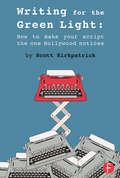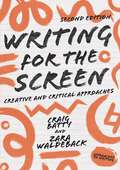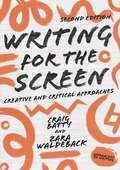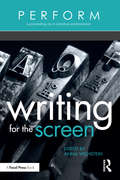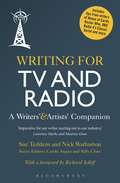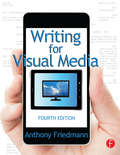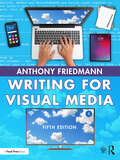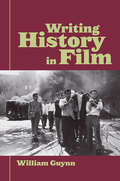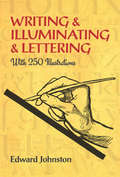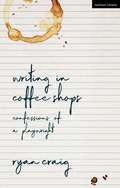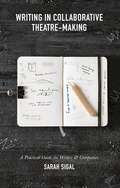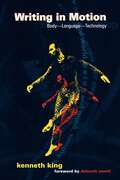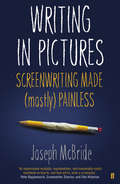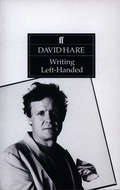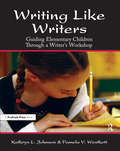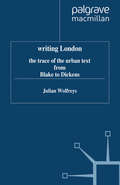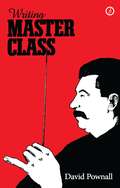- Table View
- List View
Writing for the Green Light: How to Make Your Script the One Hollywood Notices
by Scott KirkpatrickTailor your screenplay to sell. Find out what Hollywood script readers, producers, and studio executives want in a screenplay (and why) from someone who’s been there. Discover what it takes to begin a lasting career as a screenwriter. Peppered with interviews from established professionals, Writing for the Green Light: How to Make Your Script the One Hollywood Notices gives you a sharp competitive edge by showcasing dozens of everyday events that go on at the studios but are rarely if ever discussed in most screenwriting books. With his behind-the-scenes perspective, Scott Kirkpatrick shows you why the system works the way it does and how you can use its unwritten rules to your advantage. He answers such questions as: Who actually reads your script? How do you pique the interest of studios and decision makers? What do agents, producers, and production companies need in a script? How much is a script worth? What are the best genres for new writers and why? What are real steps you can take to ‘break in’ to television writing? How do you best present or pitch a project without looking desparate? How do you negotiate a contract without an agent? How do you exude confidence and seal your first deal? These and other insights are sure to give you and your screenplay a leg-up for success in this competitive landscape!
Writing for the Green Light: How to Make Your Script the One Hollywood Notices
by Scott KirkpatrickTailor your screenplay to sell. Find out what Hollywood script readers, producers, and studio executives want in a screenplay (and why) from someone who’s been there. Discover what it takes to begin a lasting career as a screenwriter. Peppered with interviews from established professionals, Writing for the Green Light: How to Make Your Script the One Hollywood Notices gives you a sharp competitive edge by showcasing dozens of everyday events that go on at the studios but are rarely if ever discussed in most screenwriting books. With his behind-the-scenes perspective, Scott Kirkpatrick shows you why the system works the way it does and how you can use its unwritten rules to your advantage. He answers such questions as: Who actually reads your script? How do you pique the interest of studios and decision makers? What do agents, producers, and production companies need in a script? How much is a script worth? What are the best genres for new writers and why? What are real steps you can take to ‘break in’ to television writing? How do you best present or pitch a project without looking desparate? How do you negotiate a contract without an agent? How do you exude confidence and seal your first deal? These and other insights are sure to give you and your screenplay a leg-up for success in this competitive landscape!
Writing for the Screen: Creative and Critical Approaches (Approaches to Writing)
by Craig Batty Zara WaldebackThis revised and refreshed edition guides the contemporary screenwriter through a variety of creative and critical approaches to a deeper understanding of how to tell stories for the screen. With a renewed focus on theme and structure, the book is an essential guide for writers, script developers and teachers to help develop ideas into rich dynamic projects, and craft compelling, resonating screenplays. Combining creative tools and approaches with critical and contextual underpinnings, the book is ideal for screenwriting students who are looking to expand their skills and reflect on practices to add greater depth to their scripts. It will also inspire experienced writers and developers to find fresh ways of working and consider how new technology is affecting storytelling voices. Comprehensive and engaging, this book considers key narrative questions of today and offers a range of exercises to address them. Integrating creative guidance with rigorous scholarship, this is the perfect companion for undergraduate students taking courses in screenwriting. Encouraging and pragmatic, it will provide a wealth of inspiration for those wishing to work in the industry or deepen their study of the practice.
Writing for the Screen: Creative and Critical Approaches
by Craig Batty Zara WaldebackThis revised and refreshed edition guides the contemporary screenwriter through a variety of creative and critical approaches to a deeper understanding of how to tell stories for the screen. With a renewed focus on theme and structure, the book is an essential guide for writers, script developers and teachers to help develop ideas into rich dynamic projects, and craft compelling, resonating screenplays. Combining creative tools and approaches with critical and contextual underpinnings, the book is ideal for screenwriting students who are looking to expand their skills and reflect on practices to add greater depth to their scripts. It will also inspire experienced writers and developers to find fresh ways of working and consider how new technology is affecting storytelling voices. Comprehensive and engaging, this book considers key narrative questions of today and offers a range of exercises to address them. Integrating creative guidance with rigorous scholarship, this is the perfect companion for undergraduate students taking courses in screenwriting. Encouraging and pragmatic, it will provide a wealth of inspiration for those wishing to work in the industry or deepen their study of the practice.New to this Edition:- Refreshed and revised edition to meet the demands of contemporary screenwriting- New case studies, models, tools and approaches to writing for the screen- Updated areas of industry practice, including web series, transmedia, VR and long-form storytelling- Includes practical approaches and creative exercises that can be used in the classroom
Writing for the Screen (PERFORM)
by Anna WeinsteinWriting for the Screen is a collection of essays and interviews exploring the business of screenwriting. This highly accessible guide to working in film and television includes perspectives from industry insiders on topics such as breaking in; pitching; developing and nurturing business relationships; juggling multiple projects; and more. Writing for the Screen is an ideal companion to screenwriting and filmmaking classes, demystifying the industry and the role of the screenwriter with real-world narratives and little-known truths about the business. With insight from working professionals, you’ll be armed with the information you need to pursue your career as a screenwriter. Contains essays by and interviews with screenwriting consultants, television writers, feature writers, writer-directors of independent film, producers, and professors. Offers expert opinions on how to get started, including preparing your elevator pitch, finding mentors, landing an internship, and moving from an internship to the next step in your career. Reveals details about taking meetings, what development executives are looking for in a screenwriter, how and when to approach a producer, and how to pitch. Explores strategies for doing creative work under pressure, finding your voice, choosing what to write, sticking with a project over the long haul, overcoming discrimination, and reinventing yourself as a writer. Illuminates the business of screenwriting in the United States (New York and Los Angeles) as compared to other countries around the globe, including England, Ireland, Peru, France, Australia, and Belgium.
Writing for the Screen (PERFORM)
by Anna WeinsteinWriting for the Screen is a collection of essays and interviews exploring the business of screenwriting. This highly accessible guide to working in film and television includes perspectives from industry insiders on topics such as breaking in; pitching; developing and nurturing business relationships; juggling multiple projects; and more. Writing for the Screen is an ideal companion to screenwriting and filmmaking classes, demystifying the industry and the role of the screenwriter with real-world narratives and little-known truths about the business. With insight from working professionals, you’ll be armed with the information you need to pursue your career as a screenwriter. Contains essays by and interviews with screenwriting consultants, television writers, feature writers, writer-directors of independent film, producers, and professors. Offers expert opinions on how to get started, including preparing your elevator pitch, finding mentors, landing an internship, and moving from an internship to the next step in your career. Reveals details about taking meetings, what development executives are looking for in a screenwriter, how and when to approach a producer, and how to pitch. Explores strategies for doing creative work under pressure, finding your voice, choosing what to write, sticking with a project over the long haul, overcoming discrimination, and reinventing yourself as a writer. Illuminates the business of screenwriting in the United States (New York and Los Angeles) as compared to other countries around the globe, including England, Ireland, Peru, France, Australia, and Belgium.
Writing for TV and Radio: A Writers' and Artists' Companion (Writers’ and Artists’ Companions)
by Sue Teddern Nick WarburtonThis essential companion offers invaluable insights and solid, practical guidance to those keen to write for TV and radio.PART 1 explores the nature of the media. It looks at the history of writing drama and comedy for radio and TV through a consideration of its key elements and some of the most successful dramas and comedies of past and present. PART 2 includes reflections and tips from award-winning writers of film, television and radio from the UK, the US and Scandinavia: Sam Bain, Peter Bowker, Elly Brewer, Laura Eason, Ellen Fairey, Nick Fisher, Phil Ford, Jeppe Gjervig Gram, Katie Hims, Rachel Joyce, Marcy Kahan, Rebecca Lenkiewicz, Jan McVerry, Jonathan Myerson, Hattie Naylor, Richard Nelson, Andrew Nickolds, Georgia Pritchett, Mike Walker and Stephen Wyatt. PART 3 offers practical advice on technical aspects of writing for TV and radio including character development, structure and dialogue. It also gives guidance on how to deal with branches of the broadcasting industry, from agents and actors to producers and script editors.
Writing for TV and Radio: A Writers' and Artists' Companion (Writers’ and Artists’ Companions)
by Sue Teddern Nick WarburtonThis essential companion offers invaluable insights and solid, practical guidance to those keen to write for TV and radio.PART 1 explores the nature of the media. It looks at the history of writing drama and comedy for radio and TV through a consideration of its key elements and some of the most successful dramas and comedies of past and present. PART 2 includes reflections and tips from award-winning writers of film, television and radio from the UK, the US and Scandinavia: Sam Bain, Peter Bowker, Elly Brewer, Laura Eason, Ellen Fairey, Nick Fisher, Phil Ford, Jeppe Gjervig Gram, Katie Hims, Rachel Joyce, Marcy Kahan, Rebecca Lenkiewicz, Jan McVerry, Jonathan Myerson, Hattie Naylor, Richard Nelson, Andrew Nickolds, Georgia Pritchett, Mike Walker and Stephen Wyatt. PART 3 offers practical advice on technical aspects of writing for TV and radio including character development, structure and dialogue. It also gives guidance on how to deal with branches of the broadcasting industry, from agents and actors to producers and script editors.
Writing for Visual Media
by Anthony FriedmannThis updated edition of Writing for Visual Media will enable you to understand the nature of visual writing that lies behind the content of all visual media. This unique kind of writing must communicate to audiences through content producers, since audiences don’t read the script. Most media content provides a solution to a communication problem, which the writer must learn to analyze and solve before writing the script. The Fourth Edition strengthens the method for creating content and writing in the correct language and established format for each visual medium, including commercial communication such as ads and PSAs, corporate communications, and training. An extended investigation into dramatic theory and how entertainment narrative works is illustrated by examples and detailed analysis of scenes, scripts and storylines, designed to save writers from typical pitfalls and releasing your creative powers of invention. Writing for Visual Media will help you to develop an improved foundation for understanding interactive media and writing for non-linear content, while gaining the tools to effectively connect with your audience like a professional. Purchase of this book includes access to the companion website, which provides: Sample scripts and video clips of those produced scripts An interactive glossary of camera shots, movements, and transitions Storyboards, scripts, screenplays, and links to industry resource Instructor materials such as PowerPoint lecture slides, a sample syllabus, and a test bank. Visit the site at www.routledgetextbooks.com/textbooks/9780415815857
Writing for Visual Media
by Anthony FriedmannThis updated edition of Writing for Visual Media will enable you to understand the nature of visual writing that lies behind the content of all visual media. This unique kind of writing must communicate to audiences through content producers, since audiences don’t read the script. Most media content provides a solution to a communication problem, which the writer must learn to analyze and solve before writing the script. The Fourth Edition strengthens the method for creating content and writing in the correct language and established format for each visual medium, including commercial communication such as ads and PSAs, corporate communications, and training. An extended investigation into dramatic theory and how entertainment narrative works is illustrated by examples and detailed analysis of scenes, scripts and storylines, designed to save writers from typical pitfalls and releasing your creative powers of invention. Writing for Visual Media will help you to develop an improved foundation for understanding interactive media and writing for non-linear content, while gaining the tools to effectively connect with your audience like a professional. Purchase of this book includes access to the companion website, which provides: Sample scripts and video clips of those produced scripts An interactive glossary of camera shots, movements, and transitions Storyboards, scripts, screenplays, and links to industry resource Instructor materials such as PowerPoint lecture slides, a sample syllabus, and a test bank. Visit the site at www.routledgetextbooks.com/textbooks/9780415815857
Writing for Visual Media
by Anthony FriedmannWriting for Visual Media provides writers with an understanding of the nature of visual writing behind all visual media. Such writing is vital for directors, actors, and producers to communicate content to audiences. Friedmann provides an extended investigation into dramatic theory and how entertainment narrative works, illustrated by examples and detailed analysis of scenes, scripts, techniques, and storylines. This new edition has a finger on the pulse of the rapidly evolving media ecosystem and explains it in the context of writing and creating content. Friedmann lays out many of the complex professional, creative, and commercial issues that a writer needs to understand in order to tell engaging stories and construct effective and professional screenplays. This new edition includes: A new chapter on storytelling A fresh examination of dramatic theory and how to apply it to constructing screenplays Updated discussion of mobile platforms A lengthened discussion of copyright, ethics, and professional development issues An updated companion website with sample scripts and corresponding videos, an interactive glossary, sample storyboards and screenplays, links to industry resources, and materials for instructors such as slides, a syllabus, and a test bank.
Writing for Visual Media
by Anthony FriedmannWriting for Visual Media provides writers with an understanding of the nature of visual writing behind all visual media. Such writing is vital for directors, actors, and producers to communicate content to audiences. Friedmann provides an extended investigation into dramatic theory and how entertainment narrative works, illustrated by examples and detailed analysis of scenes, scripts, techniques, and storylines. This new edition has a finger on the pulse of the rapidly evolving media ecosystem and explains it in the context of writing and creating content. Friedmann lays out many of the complex professional, creative, and commercial issues that a writer needs to understand in order to tell engaging stories and construct effective and professional screenplays. This new edition includes: A new chapter on storytelling A fresh examination of dramatic theory and how to apply it to constructing screenplays Updated discussion of mobile platforms A lengthened discussion of copyright, ethics, and professional development issues An updated companion website with sample scripts and corresponding videos, an interactive glossary, sample storyboards and screenplays, links to industry resources, and materials for instructors such as slides, a syllabus, and a test bank.
Writing History in Film
by William GuynnHistorical film has been an important genre since the earliest silent films. The French Revolution, the American Civil War, the conquest of the New World, World War II--all have been repeatedly represented in film. But how do we distinguish between fictionalized spectacle and authentic historical representation? Writing History in Film sets out the narratological, semiological, rhetorical, and philosophical bases for understanding how film can function as a form of historical interpretation and representation. With case studies and an interdisciplinary approach, William Guynn examines the key issues facing film students and scholars, historians, and anyone interested in how we see our historical past.
Writing History in Film
by William GuynnHistorical film has been an important genre since the earliest silent films. The French Revolution, the American Civil War, the conquest of the New World, World War II--all have been repeatedly represented in film. But how do we distinguish between fictionalized spectacle and authentic historical representation? Writing History in Film sets out the narratological, semiological, rhetorical, and philosophical bases for understanding how film can function as a form of historical interpretation and representation. With case studies and an interdisciplinary approach, William Guynn examines the key issues facing film students and scholars, historians, and anyone interested in how we see our historical past.
Writing & Illuminating & Lettering: With 250 Illustrations
by Edward JohnstonOne of the founders of modern calligraphy, Edward Johnston regarded lettering, writing, and illuminating as not only desirable ends in themselves but also as practical avenues to mastery of typography, decoration, and design. In this classic, profusely illustrated guide, he distilled his expertise into a series of easy-to-follow lessons that will benefit any student of calligraphy, book design, or art.Part I is devoted to writing and illuminating. Early chapters cover the fundamentals of acquiring a formal hand: choosing paper, ink, and quills; holding the pen; spacing and planning a manuscript; and more. The author then turns to the techniques of producing a manuscript book: tools and materials, methods and proportions, margins, and other methods. Part II offers a detailed discussion of lettering: the qualities of good lettering, methods of construction and arrangement, spacing, proportion, and other matters. Two appendixes cover the uses of lettering in book bindings, wall inscriptions, monograms, and title pages as well as the techniques involved in lettering on metal, wood, and stone.
Writing in Coffee Shops: Confessions of a Playwright
by Ryan CraigWhat makes someone a playwright?How do their identities and ideas interweave and co-exist?What permanent truths can we discern from examining existing texts?How can we write theatre that encapsulates the contemporary moment?How do we develop an idea from the embryonic impulse to a full and robust piece of theatre? In this fresh, lively and often very funny book, playwright Ryan Craig makes a case for the vitality of playwriting in our contemporary world and offers a way into writing those plays.From the very first moment of the process, as you sit in a coffee shop, staring at your 'laptop yawning open like some big, gormless mouth, the screen a flickering blank', to seeing your play staged and reviewed, the author takes you through the complete journey. Drawing on his own experience of writing for theatres such as the National, Hampstead and Tricycle and Menier Chocolate Factory, TV drama scripts for BBC, ITV and Channel Four, radio plays and adaptation, as well as commercial theatre, the author explores what practical tools the dramatist can use to write plays that build bridges between us. Full of practical advice for the aspiring - and practising - playwright, this book is also an important call-to-arms for playwrights everywhere, arguing for its necessity in the context of an increasingly fractured, distracted, disconnected world.
Writing in Coffee Shops: Confessions of a Playwright
by Ryan CraigWhat makes someone a playwright?How do their identities and ideas interweave and co-exist?What permanent truths can we discern from examining existing texts?How can we write theatre that encapsulates the contemporary moment?How do we develop an idea from the embryonic impulse to a full and robust piece of theatre? In this fresh, lively and often very funny book, playwright Ryan Craig makes a case for the vitality of playwriting in our contemporary world and offers a way into writing those plays.From the very first moment of the process, as you sit in a coffee shop, staring at your 'laptop yawning open like some big, gormless mouth, the screen a flickering blank', to seeing your play staged and reviewed, the author takes you through the complete journey. Drawing on his own experience of writing for theatres such as the National, Hampstead and Tricycle and Menier Chocolate Factory, TV drama scripts for BBC, ITV and Channel Four, radio plays and adaptation, as well as commercial theatre, the author explores what practical tools the dramatist can use to write plays that build bridges between us. Full of practical advice for the aspiring - and practising - playwright, this book is also an important call-to-arms for playwrights everywhere, arguing for its necessity in the context of an increasingly fractured, distracted, disconnected world.
Writing in Collaborative Theatre-Making (PDF)
by Sarah SigalThis engaging text explores the role of the writer and the text in collaborative practice through the work of contemporary writers and companies working in Britain, offering students and aspiring writers and directors effective practical strategies for collaborative work.
Writing in Motion: Body—Language—Technology
by Kenneth KingKenneth King is one of America's most inventive postmodern choreographers. His dancing has always reflected his interest in language and technology, combining movement with film, machines, lighting and words both spoken and written. King is also conversant in philosophy, and some of his most influential dances have been dedicated to and in dialogue with the work of such philosophers as Susanne K. Langer, Edmund Husserl and Friedrich Nietzsche. Since the 1960s, he has performed his dance to texts both spoken and prerecorded—texts intended to stand separately as literary works.Writing in Motion spans more than thirty years and is collected here for the first time. It includes essays, performance scripts of King's own work, art criticism, philosophy and cultural commentary. Dense with movement, these writings explode and reconfigure the familiar, crack syntax open, and invent startling new words. Dancing, to King, is "writing in space," and writing is a dance of ideas. Whether referencing Aristotle, Langer, Simone de Beauvoir, MTV, Maurice Blanchot or Marshall McLuhan, King's delightfully lavish prose is very much "in motion."
Writing in Pictures: Screenwriting Made (Mostly) Painless
by Joseph McBrideUnlike most how-to books on screenwriting, Writing in Pictures is highly practical, offering a realistic guide to the screenwriting profession, as well as concrete practical guidance in the steps professional writers take to write a screenplay that comes from the heart instead of the pocketbook. The readeris taken through the nitty-gritty process of conceiving, outlining, constructing, and writing a screenplay in the professional format, with clear and concise examples offered for every step in writing a short dramatic film.Writing in Pictures offers straight talk, no mumbo-jumbo or gimmicks, just a methodical, step-by-step process that walks the reader through the different stages of writing a screenplay -- from idea to outline to character biography to treatment to step outline to finished screenplay. Using well-known films and screenplays, both contemporary and classic, to illustrate its lessons, Writing in Pictures also offers comments from famous screenwriters past and present and insightful stories (often colorful and funny) that illuminate aspects of the craft.
Writing Left-Handed: Collected Essays
by David HareThe leading British writer-director of his generation, David Hare is also one of the most productive. The last two years have seen the outstanding success of two stage plays, The Secret Rapture and Racing Demon, and the release of two films, Paris by Night and Strapless.The pieces collected here, written left-handed, form both a concealed professional autobiography and a lucid commentary on his work.
Writing Like Writers: Guiding Elementary Children Through a Writer's Workshop
by Pamela V. Westkott Kathryn L. JohnsonBuild a classroom of excited, talented young writers. This wonderful teaching resource offers a complete approach to creating a classroom of enthusiastic, skillful student writers.The authors provide a comprehensive approach to teaching writing in the classroom. This book offers the strategies teachers need to teach writing skills that meet national standards and to produce excellent results from children.Topics addressed in this guidebook include:creating the writing classroom,teaching the writing process,teaching effective writing strategies,teaching elements of story structure,teaching the advanced craft of writing, andusing a writer's workshop to teach good writing. Writing is a great differentiator. During the writer's workshop, each student is engaged in meaningful ways. Pulling together more than three decades of practical experience and research on the best strategies for teaching writing, Writing Like Writers offers a friendly, easy-to-use guide for any teacher seeking to build a classroom of successful writers.Grades 2-6
Writing Like Writers: Guiding Elementary Children Through a Writer's Workshop
by Pamela V. Westkott Kathryn L. JohnsonBuild a classroom of excited, talented young writers. This wonderful teaching resource offers a complete approach to creating a classroom of enthusiastic, skillful student writers.The authors provide a comprehensive approach to teaching writing in the classroom. This book offers the strategies teachers need to teach writing skills that meet national standards and to produce excellent results from children.Topics addressed in this guidebook include:creating the writing classroom,teaching the writing process,teaching effective writing strategies,teaching elements of story structure,teaching the advanced craft of writing, andusing a writer's workshop to teach good writing. Writing is a great differentiator. During the writer's workshop, each student is engaged in meaningful ways. Pulling together more than three decades of practical experience and research on the best strategies for teaching writing, Writing Like Writers offers a friendly, easy-to-use guide for any teacher seeking to build a classroom of successful writers.Grades 2-6
Writing London: The Trace of the Urban Text from Blake to Dickens
by J. WolfreysWriting London asks the reader to consider how writers sought to respond to the nature of London. Drawing on literary and architectural theory and psychoanalysis, Julian Wolfreys looks at a variety of nineteenth-century writings to consider various literary modes of productions as responses to the city. Beginning with an introductory survey of the variety of literary representations and responses to the city, Writing London follows the shaping of the urban consciousness from Blake to Dickens, through Shelley, Barbauld, Byron, De Quincey, Engels and Wordsworth. It concludes with an Afterword which, in developing insights into the relationship between writing and the city, questions the heritage industry's reinvention of London, while arguing for a new understanding of the urban spirit.
Writing 'Master Class'
by David PownallWriting Master Class is the biography of David Pownall’s play, Master Class (1983), from conception to coming of age. Threaded through the account of the inception and development of the piece are twists of authorial life-story necessary for the telling. Whereas a novel or poem can be kept a secret until it is properly finished, a play has to go out to meet the people early. On the day the script is put into the hands of actors, the soul of the thing passes out of the author’s control. It can be bent, battered, warped – or improved within its being far beyond expectations. As a drama of dictatorship in art and the cleverness needed to evade its worst manifestations, Master Class has been at large for thirty years, produced in twenty countries, in some several times. What has been done to it, how it has fared, is touched upon but the main story in this book is the making of the piece. This is a fascinating insight into the playwright’s craft.
